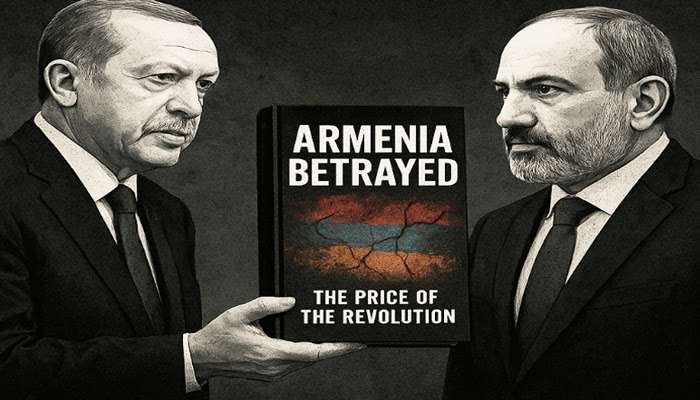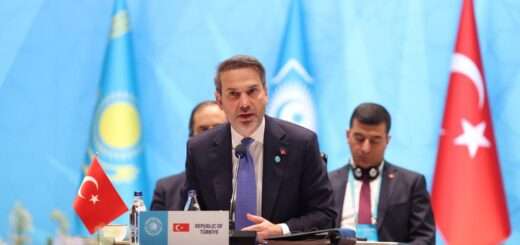From Ankara to Yerevan: The Erdoğan Blueprint Behind Pashinyan’s Rise

By Wally Sarkeesian
Gagrule.net
When Armenian Prime Minister Nikol Pashinyan visited Istanbul earlier this year, Turkish President Recep Tayyip Erdoğan handed him a copy of his book. To most observers, it was a symbolic diplomatic gesture. But to those watching closely, the moment carried a deeper meaning: Pashinyan’s political career had already followed Erdoğan’s blueprint step by step.
From prison cells to popular revolutions, from promises of peace to the concentration of power, both leaders built their dominance on a strikingly similar playbook. Whether by coincidence or careful imitation, Pashinyan’s rise mirrors Erdoğan’s rise with unsettling precision.
Phase 1: From Prison to Power
Erdoğan’s Path: In 1997, Erdoğan, then Mayor of Istanbul, was jailed for reciting a poem deemed inflammatory. Far from ending his career, prison turned him into a martyr. In 2001, he co-founded the AKP, which swept the 2002 elections. Though initially banned from office, Erdoğan soon entered parliament and became Prime Minister in 2003. His narrative was simple: “I was oppressed, but the people raised me up.”
Pashinyan’s Path: Similarly, Pashinyan was imprisoned after the 2008 protests in Armenia. Released in 2011 under amnesty, he returned to politics stronger. By 2018, he led the Velvet Revolution, toppling Serzh Sargsyan and becoming Prime Minister. But his rise was not only about protest — it was also about political blackmail and populist pressure:
- He leveraged mass street demonstrations to corner the ruling elite.
- He declared: “Either me, or no one else will be Prime Minister.”
- During the snap election process, Pashinyan pressured the opposition not to nominate alternative candidates, knowing he had the people’s backing.
- The opposition reluctantly conceded, leaving Pashinyan the sole viable choice.
With this maneuver, he not only won power but also established the precedent that his authority came directly from the street, above institutions.
Blueprint Lesson #1: Turn prison into legitimacy. Combine victimhood with populist blackmail until rivals have no choice but to step aside.
Phase 2: The Illusion of Peace
Erdoğan: In the 2000s, Erdoğan charmed the West as a reformer, even launching a peace process with the Kurds (2009–2013). Kurds gained cultural rights and political representation. But by 2015, the peace collapsed. Erdoğan pivoted to nationalism, and Kurds were left betrayed — their trust used as political capital.
Pashinyan: After 2018, Pashinyan spoke the language of peace and democracy. He promised reforms and reconciliation, even softening Armenia’s stance on Artsakh. But behind the rhetoric, he was already weaponizing peace against rivals:
- He branded critics of his peace agenda as “enemies of democracy” or “warmongers.”
- He positioned himself as the only leader brave enough to pursue peace, echoing his earlier “either me or no one” posture.
- By labeling alternatives as dangerous, he created a climate where supporting him appeared to be the only path to stability.
Blueprint Lesson #2: Promise peace to win trust. Use reconciliation as both a mask and a weapon to delegitimize rivals.
Phase 3: Centralizing Control
Erdoğan: Step by step, Erdoğan captured Turkey’s institutions. Courts filled with loyalists, media silenced or bought out, police and military purged. In 2017, he replaced parliamentary democracy with a presidential system, making himself the ultimate power.
Pashinyan: In Armenia, Pashinyan’s “reforms” steadily stripped institutions of independence and concentrated authority in his hands.
- Judiciary: He pushed for a “transitional justice system” to purge judges, but this meant replacing them with loyalists.
- Military: When generals demanded his resignation in 2021, Pashinyan dismissed them outright, asserting control and showing that the army would serve the Prime Minister, not the constitution.
- Parliament: He forced early elections under his own terms. With the opposition fractured, his party secured dominance.
- People as leverage: Each time his authority was questioned, Pashinyan invoked the “will of the people,” using street legitimacy to overwhelm institutions.
Blueprint Lesson #3: Capture institutions under the banner of reform. When that fails, invoke the people’s will until only one voice remains.
Phase 4: Exploiting Crisis
Erdoğan: The failed 2016 coup attempt became Erdoğan’s greatest gift. Within hours, he called citizens into the streets via FaceTime. The coup collapsed, and Erdoğan launched mass purges of military, judiciary, media, and academia. By declaring a state of emergency, he ruled by decree and emerged unchallenged.
Pashinyan: Armenia’s catastrophic 2020 war should have ended his career. Instead, Pashinyan turned defeat into survival:
- Critics of the capitulation were branded as “traitors” and “war profiteers.”
- Opposition protests were suppressed, and activists were arrested.
- In the 2021 snap elections, he warned that opposing him meant risking national collapse. His party won a renewed mandate.
Like Erdoğan, Pashinyan transformed disaster into opportunity — not by saving the country, but by blackmailing society with fear of worse chaos without him.
Blueprint Lesson #4: Never waste a crisis. War, defeat, or even a coup can be turned into a weapon to silence rivals and consolidate power.
Phase 5: Aftermath & Legacy
Erdoğan’s Turkey: What began as democratic hope ended in authoritarian rule. Turkey is polarized, institutions hollowed out, and journalists silenced. Yet Erdoğan remains, presenting himself as the nation’s indispensable protector.
Pashinyan’s Armenia: Once hailed as the face of democratic renewal, Pashinyan has left Armenia weaker and more divided. Institutions now serve his survival rather than the country’s resilience. Supporters call it reform. Critics call it betrayal.
Blueprint Lesson #5: A leader’s legacy is not in promises, but in the system left behind. Both Erdoğan and Pashinyan leave nations weakened, institutions gutted, but their own power intact.

Phase 6 → The Church Under Siege No nation can stand without its spiritual backbone. For Armenians, that backbone has always been the Apostolic Church — a guardian of faith, culture, and continuity through centuries of struggle. Yet under Pashinyan’s leadership, this institution too has come under pressure.
The government’s rhetoric has sought to sideline the Church, framing it as outdated and unnecessary in modern governance. This mirrors Erdoğan’s earlier tactics in Turkey: reshaping religious authority and bending institutions to political will. Where Erdoğan co-opted religion to strengthen his power, Pashinyan appears determined to weaken Armenia’s own spiritual anchor, creating deep divisions between Church and state

Pashinyan police Storming Armenian church
For many Armenians, this attack is not just political, but existential. The Church has long symbolized unity and survival; undermining it risks eroding the very identity of the nation. In this sense, the blueprint extends beyond politics and war — it penetrates the soul of Armenia itself.
From Ankara to Yerevan, the same script has been performed:
Conclusion: The Book as Blueprint
The image of Erdoğan handing Pashinyan his book in Istanbul is more than a diplomatic courtesy. It is symbolic of a political truth: Erdoğan wrote the manual, and Pashinyan applied it in Armenia.
From Ankara to Yerevan, the same script has been performed:
- Prison → Power.
- Peace → Control.
- Crisis → Consolidation.
For Turkey, this meant the rise of Erdoğan’s personal rule. For Armenia, it has meant defeat, division, and a hollowed state.
The shadow of Erdoğan’s playbook stretches across borders — and Pashinyan has walked its path step by step.





